| Article ID | Journal | Published Year | Pages | File Type |
|---|---|---|---|---|
| 6815192 | Psychiatry Research | 2014 | 6 Pages |
Abstract
This study aimed at estimating the protective effect of suicide precautions and clinical risk factors for inpatient suicides. A standardized precaution system was implemented in a large psychiatric center on January 1, 1996. A consecutive series of 33,121 admissions from 1998 to 2008 constituted the post-implementation cohort and 13,515 admissions from 1985 to 1995 constituted the pre-implementation cohort as comparison group. Inpatient suicides were identified via record linkage with national mortality database. For each of 41 inpatient suicides, four controls were randomly selected based on a nested case-control study. A standardized chart review process was employed to collate clinical information for each study subject. Risk and protective factors for inpatient suicides was estimated by conditional logistic regression. The findings showed that, among subjects with shorter lengths of stay, those admitted in post-implementation era had a significantly lower adjusted risk ratio (0.157, p=0.048) for inpatient suicides. Three depression-related symptoms elevated the risk for inpatient suicides: depressed mood (adjusted risk ratio=2.11, P=0.002), loss of energy (adjusted risk ratio=1.99, P=0.018), and psychomotor retardation (adjusted risk ratio=1.67, P=0.066; with marginal statistical significance). Suicide precautions have protective effect against inpatient suicides. A better assessment and prevention efforts is needed, particularly for those with depression-related symptoms.
Related Topics
Life Sciences
Neuroscience
Biological Psychiatry
Authors
Shi-Kwang Lin, Tsui-Mei Hung, Ya-Tang Liao, Wen-Chung Lee, Shang-Ying Tsai, Chiao-Chicy Chen, Chian-Jue Kuo,
